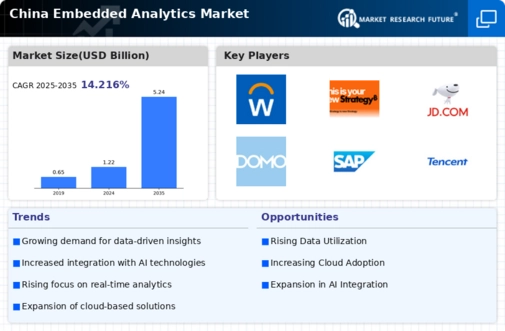Increased Adoption of Cloud Computing
The transition to cloud computing is significantly influencing the embedded analytics market in China. As businesses migrate their operations to the cloud, the demand for embedded analytics solutions that can seamlessly integrate with cloud platforms is on the rise. This trend is particularly pronounced among small and medium-sized enterprises (SMEs) that seek cost-effective solutions to enhance their data capabilities. The cloud offers scalability, flexibility, and accessibility, which are essential for organizations aiming to harness the power of analytics. Reports indicate that the cloud services market in China is expected to reach $50 billion by 2026, further propelling the adoption of embedded analytics tools that can operate efficiently in cloud environments.
Growing Focus on Operational Efficiency
In the competitive landscape of China, businesses are increasingly prioritizing operational efficiency, which is driving the embedded analytics market. Organizations are utilizing analytics to streamline processes, reduce costs, and enhance productivity. By embedding analytics into their workflows, companies can identify bottlenecks and optimize resource allocation. This trend is particularly relevant in sectors such as logistics and manufacturing, where efficiency gains can lead to substantial cost savings. The embedded analytics market is likely to benefit from this focus, as companies seek solutions that provide actionable insights directly within their operational systems, thereby fostering a culture of continuous improvement.
Regulatory Changes and Compliance Needs
The regulatory landscape in China is evolving, with new data protection laws and compliance requirements impacting the embedded analytics market. Organizations are compelled to adopt analytics solutions that not only provide insights but also ensure compliance with regulations such as the Personal Information Protection Law (PIPL). This has led to an increased demand for embedded analytics tools that incorporate robust security features and data governance capabilities. Companies are seeking solutions that can help them navigate the complexities of compliance while still delivering valuable insights. As regulatory scrutiny intensifies, the embedded analytics market is likely to see a rise in demand for solutions that prioritize data security and compliance.
Emergence of Advanced Analytics Capabilities
The embedded analytics market in China is witnessing the emergence of advanced analytics capabilities, including predictive and prescriptive analytics. These sophisticated tools enable organizations to not only analyze historical data but also forecast future trends and recommend actions. As businesses strive to stay ahead of the competition, the integration of advanced analytics into their operations becomes increasingly vital. This trend is particularly relevant in industries such as finance and healthcare, where data-driven insights can lead to better decision-making and improved outcomes. The growing sophistication of analytics tools is likely to attract more investments in the embedded analytics market, as companies recognize the potential for enhanced strategic planning.
Rising Demand for Data-Driven Decision Making
The embedded analytics market in China is experiencing a surge in demand as organizations increasingly recognize the value of data-driven decision making. Companies are leveraging analytics to gain insights into customer behavior, operational efficiency, and market trends. This shift is evident in various sectors, including finance, retail, and manufacturing, where data analytics tools are being integrated into existing systems. According to recent estimates, the market for embedded analytics solutions in China is projected to grow at a CAGR of approximately 20% over the next five years. This growth is driven by the need for real-time data access and the ability to make informed decisions quickly, positioning embedded analytics as a critical component in the digital transformation strategies of Chinese enterprises.


























Leave a Comment